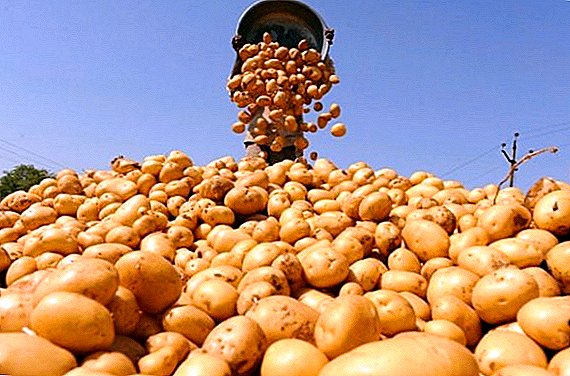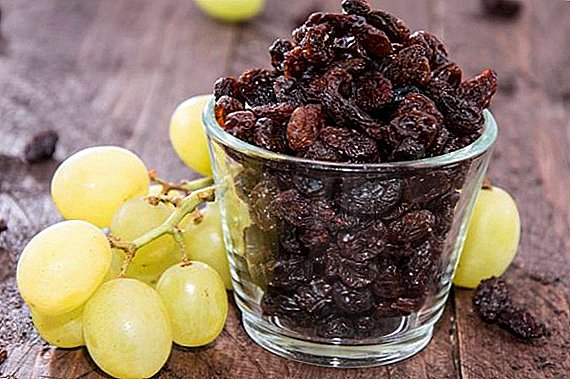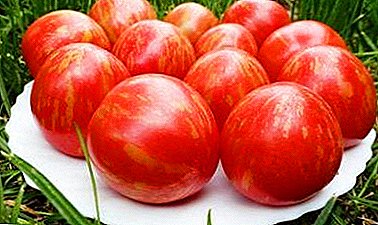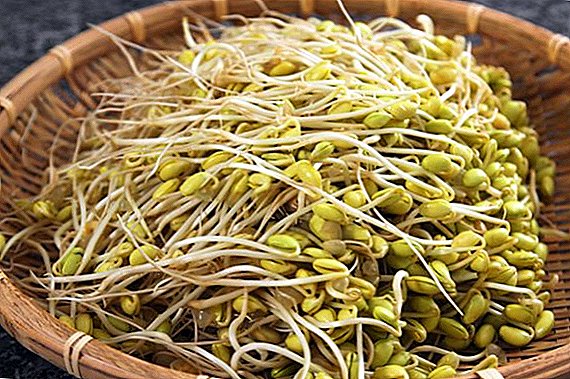 Supporters of healthy eating often tend to replace animal food with vegetable. However, in this case, many are faced with the problem of compensation of proteins and other beneficial substances in the body. To date, there are already quite a lot of products of plant origin, which can partially replace animal protein for those who do not use it for any reason. One of such products is germinated soy, which will be discussed.
Supporters of healthy eating often tend to replace animal food with vegetable. However, in this case, many are faced with the problem of compensation of proteins and other beneficial substances in the body. To date, there are already quite a lot of products of plant origin, which can partially replace animal protein for those who do not use it for any reason. One of such products is germinated soy, which will be discussed.
Soy sprouts
Soy is a bean product, it has been grown in China for many centuries, but in European countries it gained popularity only in the 19th century.
Soy sprouts are used in the preparation of various dishes and salads, depending on the origin of the beans, the taste qualities may differ. In the processed form, they are similar in taste with asparagus, slightly sweetish, without a pronounced aroma and taste, and in fresh - have a bitter note.
In appearance, sprouts resemble wheat germ and look like small beans with long white shoots.
Did you know? Initially, soybeans were considered food for the poor in Asian countries. At the same time, the product was subjected to prolonged fermentation before use in order to reduce the content of phytohormones and toxins.

The composition of the product
Soy is incredibly popular in the USA, Europe and around the world due to its rich unique composition.
Vitamins
Soybean itself is rich in vitamins, but when sprouting beans, the concentration of some increases. Thus, in the germinated grain, vitamin C, which is absent before, appears, the content of B vitamins and vitamin E increases almost 2 times, and vitamin K is also present.
Minerals
In addition to vitamins, soybean sprouts include in their composition an optimal set of minerals, sugars and fiber: magnesium, sodium, potassium, manganese, zinc, iron, selenium, phosphorus. 
BJU
In terms of its composition, soybean is predominantly a protein product: proteins in 100 grams of the product contain an average of 13.1 g, fats - 6.7 g, carbohydrates - 9.6 g.
In this case, the composition includes fatty acids, especially polyunsaturated (linoleic acid), which are not produced by the human body and come only from external sources.
We recommend to get acquainted with the beneficial properties of legumes such as peas, beans, black, white, red, green beans and green beans.
Calorie Product
The calorie content of soybean sprouts is quite low: 100 grams of the product contain 141 kcal, which is about 5.5% of the daily calorie intake.
Video: useful properties of soybean sprouts
The benefits of soybean germ
The ratio of vitamins and minerals in soybean sprouts makes the product very useful for many body systems:
- Primarily due to antioxidants, vitamin C and selenium, soy helps strengthen the body's resistance to infections and viruses, strengthens the immune system.
To improve immunity, you should also use dogwood, bee pollen, echinacea, ivan tea, pumpkin, blackberry, yucca, safflower, fenugreek, viburnum and black cumin oil.
- Magnesium, which is part of the product, helps to normalize the work of the nervous system, blood vessels, removes bad cholesterol, nourishes brain cells.
- Folic acid has a beneficial effect on the blood system.
- Soy sprouts are low-calorie foods, help cleanse the intestines and are ideal for people on a diet.
Eating grape leaves, milk fungus, daikon, cherry, jalapeno, radishes also helps cleanse the intestines.
- The isoflavones that make up the product regulate human hormones, stimulate reproductive function, reduce the negative manifestations of menopause in women.

Harm of germinated grains
Of course, like any product, soy sprouts have contraindications that need to be remembered:
- Germinated soy is absolutely not recommended for children under 12 years old - this is due to the fact that the phytoestrogen contained in it can adversely affect puberty, disrupting the natural hormonal balance.
- People suffering from diseases of the thyroid gland should also abandon this product before consulting a doctor, because soy helps to reduce iodine content and without following additional preventive measures may result in impaired organ functions.
- In diseases of the pancreas and gastric ulcers, urolithiasis from soybean germs should refrain.
- With great care and only after consulting with the gynecologist, you can use soy pregnant - with the slightest hint of hormonal problems, the product should be immediately canceled.
- During lactation, soybean sprouts should be treated with caution. If you have not eaten them before, you should not start, and if your body is already familiar with the product, you can try a small amount of sprouts first and follow the condition of the child. In the absence of allergies and gases in the baby, the portion can be slightly increased, but not exceed the daily rate.

How to choose and whether to store sprouts
When buying ready, already sprouted soybean seeds, you need to carefully select the product:
- First of all, pay attention to the appearance and smell - sprouts must be fresh in appearance, without foreign smells, without impurities of dirt, completely clean and juicy.
- The length of the stalk should not exceed 1 cm, otherwise there is a risk of running into an "old" product that does not carry significant benefits.
- The finished product in the store should be in the refrigerator compartment. After purchase, grain can also be stored only in the refrigerator.
Important! Germinated soy retains its benefits for several days (the maximum concentration of beneficial elements in the first 48 hours), after which the plant begins to grow, and the nutritional properties gradually decrease.
How to germinate grains at home
According to experienced sprouting soybean consumers, the best way to get the most useful product is to sprout soybeans on your own. 
Selection features
To germinate soy pleased you with fresh sprouts and was safe to eat, you need to carefully select the raw materials. It is known that soybeans are treated with various substances that may be hazardous to health.
Familiarize yourself with the nuances of proper planting of soybeans, as well as find out what soybean meal is.
First of all, it concerns seeds that are not intended for culinary purposes, but for planting - in this case they can be pre-treated with growth stimulants and antibiotics. For this reason, you need to buy soy only in specialized stores or pharmacies, where it passes the appropriate control.
Grains need to be sorted, discarding damaged, and then pour cold water to determine their suitability. If the grains float, you can safely throw them away - they will not germinate. 
Germination rules
In order for the seeds to sprout well, you need to adhere to the basic rules:
- Grains should be well washed (you can wash them in a weak solution of potassium permanganate, and then rinse several times in cold water).
- Sprouts actively develop in the dark.
- The seed should germinate in conditions of high humidity and good aeration, the water should not stagnate in the container.
For sprouting craftsmen offer to use a variety of improvised means. It is most convenient to do this in a flower pot: it has drainage holes through which excess water is drained, and it is conveniently located on the kitchen table.
To do this, prepared seeds are poured into a pot, poured with cold water and covered with a thick dark cloth. Subsequently, the grain must be watered every 2-3 hours, and on the third day you will be able to get an excellent crop of seedlings.  Some use a rather unusual way: sprout soybeans in juice boxes. To do this, pour the prepared seeds into the washed box, pour water in and cut the tank in several places in the corners to provide drainage.
Some use a rather unusual way: sprout soybeans in juice boxes. To do this, pour the prepared seeds into the washed box, pour water in and cut the tank in several places in the corners to provide drainage.
In this case, it is often not necessary to water the grains; it is enough to pour cold water twice a day and allow it to flow. In both cases, the germination of most seeds occurs on day 3. The finished product before eating should be washed in cold water. If within 48 hours the seeds do not sprout, they can not be eaten.
We advise you to get acquainted with the beneficial properties of germinated wheat grains.
How to cook a sprouted soybeans: cooking salad
Since soybeans germinate under conditions of constant humidity and heat, in addition to sprouts, pathogenic bacteria can begin to develop in it, therefore, raw seedlings cannot be eaten.
To avoid possible poisoning, the product is subjected to blanching in boiling water for no more than 30-60 seconds in order to preserve a maximum of useful substances.  Soy sprouts are used in various dishes (side dishes, sandwiches, salads) both fresh and fried. Of course, the product that has undergone minimal heat treatment is most useful, so let's take a look at the recipe for a simple and nutritious salad, indispensable for the season of viruses and colds.
Soy sprouts are used in various dishes (side dishes, sandwiches, salads) both fresh and fried. Of course, the product that has undergone minimal heat treatment is most useful, so let's take a look at the recipe for a simple and nutritious salad, indispensable for the season of viruses and colds.
Ingredients Required
- Soy sprouts;
- soy sauce;
- balsamic vinegar (can be replaced with regular);
- ground black pepper;
- chili flakes;
- garlic (1-2 cloves);
- sunflower oil.
Important! People suffering from hormonal disorders, and children should not eat soy sprouts without consulting a doctor due to the high content of phytohormones.
Step-by-step list of actions
- We rinse the soya sprouts with cold water and place them in prepared deep dishes.
- Fill sprouts with boiling water and leave for 10 minutes, then drain the water.
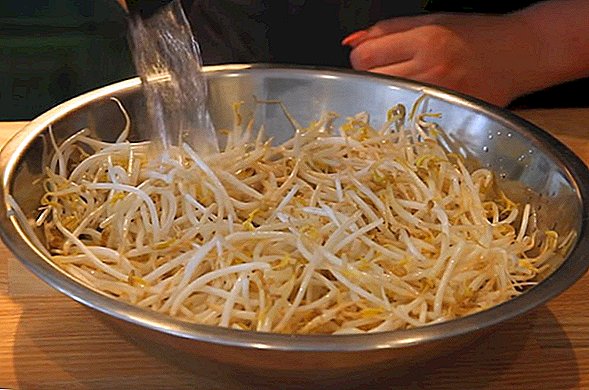
- We sprinkle the sprouts with soy sauce to taste, evenly distributing.

- Add balsamic or regular table vinegar.
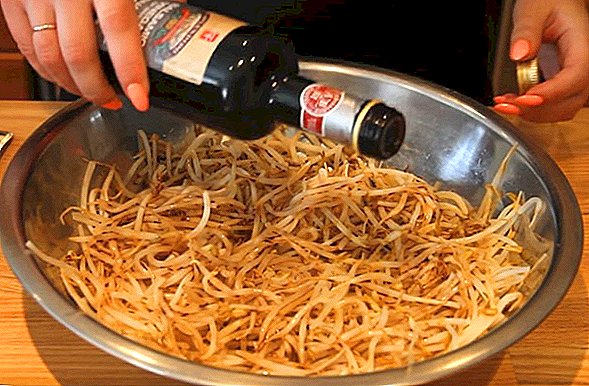
- Sprinkle with black pepper and mix the sprouts with marinade.
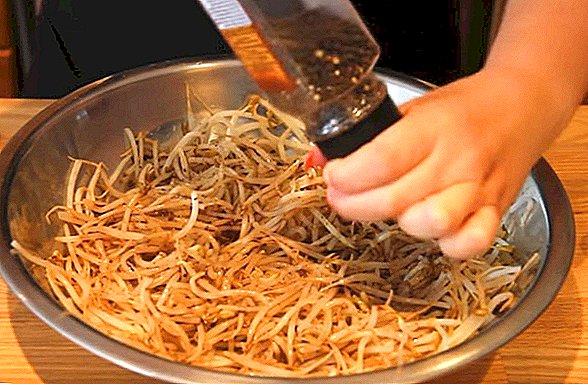
Did you know? Contrary to the belief that the Japanese and the Chinese use a huge amount of soy, statistics say that the average portion of the product for Asians is no more than 2 tablespoons per day and, mainly, in the form of food supplements.
- Make a well in the center of the mixture, squeeze the garlic in there and add the chili pepper.

- Heat the sunflower oil in a frying pan, do not bring it to a boil, pour garlic and chili over it, sprinkle with sprouts on top.

- Cover the salad with a lid and leave for half an hour.

- After the time has elapsed, stir for another 5 minutes, then you can try.
So, we have learned that it is such a simple, at first glance, product, as sprouts of soybean, we got acquainted with its composition and useful properties and contraindications. The above allows us to conclude that germinated soy is really a storehouse of vitamins and protein, and therefore, if used properly and following the measures, will bring undoubted benefits to the body.










